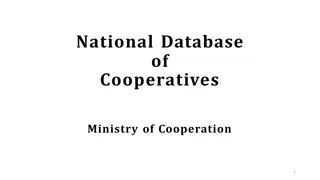Database Design Process and Concepts
This lecture on designing databases covers the database design process, normalization, transforming E-R diagrams, physical database design concepts, and steps in logical database modeling. It highlights the importance of logical and physical database design in system development, providing insights into creating efficient and well-structured database models. Students will learn how to choose storage formats, translate relational models into database tables, and utilize different file organizations effectively. The content emphasizes the significance of indexes and considerations for selecting attributes when indexing database tables.
- Database design
- Normalization
- Relational database model
- Physical database design
- Logical database modeling
Download Presentation

Please find below an Image/Link to download the presentation.
The content on the website is provided AS IS for your information and personal use only. It may not be sold, licensed, or shared on other websites without obtaining consent from the author. Download presentation by click this link. If you encounter any issues during the download, it is possible that the publisher has removed the file from their server.
E N D
Presentation Transcript
CSE 414 Systems Analysis and Design Lecture #8 Designing Databases Prepared & Presented byAsst. Prof. Dr. Samsun M. BA ARICI
Learning Objectives Describe the database design process, its outcomes, and the relational database model. Describe normalization and the rules for second and third normal form. Transform an entity-relationship (E-R) diagram into an equivalent set of well-structured (normalized) relations. Merge normalized relations from separate user views into a consolidated set of well-structured relations. Lecture #8 Designing Databases 2
Learning Objectives (Cont.) Describe physical database design concepts: Choose storage formats for fields in database tables. Translate well-structured relations into efficient database tables. Explain when to use different types of file organizations to store computer files. Describe the purpose of indexes and the important considerations in selecting attributes to be indexed. Lecture #8 Designing Databases 3
Introduction FIGURE 9-1 Systems development life cycle with design phase highlighted Lecture #8 Designing Databases 4
Database Design File and database design occurs in two steps. 1. Develop a logical database model, which describes data using notation that corresponds to a data organization used by a database management system. Relational database model 2. Prescribe the technical specifications for computer files and databases in which to store the data. Physical database design provides specifications Logical and physical database design in parallel with other system design steps Lecture #8 Designing Databases 5
The Process of Database Design FIGURE 9-2 Relationship between data modeling and the systems development life cycle Lecture #8 Designing Databases 6
The Process of Database Design (Cont.) Four key steps in logical database modeling and design: Develop a logical data model for each known user interface for the application using normalization principles. Combine normalized data requirements from all user interfaces into one consolidated logical database model (view integration). Translate the conceptual E-R data model for the application into normalized data requirements. Compare the consolidated logical database design with the translated E-R model and produce one final logical database model for the application. 1. 2. 3. 4. Lecture #8 Designing Databases 7
Physical Database Design Key physical database design decisions include: Choosing a storage format for each attribute from the logical database model. Grouping attributes from the logical database model into physical records. Arranging related records in secondary memory (hard disks and magnetic tapes) so that records can be stored, retrieved and updated rapidly. Selecting media and structures for storing data to make access more efficient. Lecture #8 Designing Databases 8
Deliverables and Outcomes Logical database design Must account for every data element on a system input or output Normalized relations are the primary deliverable. Physical database design Converts relations into database tables Programmers and database analysts code the definitions of the database. Written in Structured Query Language (SQL) Lecture #8 Designing Databases 9
Relational Database Model Relational database model: data represented as a set of related tables or relations Relation: a named, two-dimensional table of data; each relation consists of a set of named columns and an arbitrary number of unnamed rows Lecture #8 Designing Databases 10
FIGURE 9-3 (d) Conceptual data model and transformed relations Lecture #8 Designing Databases 11
Relational Database Model (Cont.) Relations have several properties that distinguish them from nonrelational tables: Entries in cells are simple. Entries in columns are from the same set of values. Each row is unique. The sequence of columns can be interchanged without changing the meaning or use of the relation. The rows may be interchanged or stored in any sequence. Lecture #8 Designing Databases 12
Well-Structured Relation and Primary Keys Well-Structured Relation (or table) A relation that contains a minimum amount of redundancy Allows users to insert, modify, and delete the rows without errors or inconsistencies Primary Key An attribute whose value is unique across all occurrences of a relation All relations have a primary key. This is how rows are ensured to be unique. A primary key may involve a single attribute or be composed of multiple attributes. Lecture #8 Designing Databases 13
Normalization and Rules of Normalization Normalization: the process of converting complex data structures into simple, stable data structures The result of normalization is that every nonprimary key attribute depends upon the whole primary key. Lecture #8 Designing Databases 14
Normalization and Rules of Normalization (Cont.) First Normal Form (1NF) Unique rows, no multivalued attributes All relations are in 1NF Second Normal Form (2NF) Each nonprimary key attribute is identified by the whole primary key (called full functional dependency) Third Normal Form (3NF) Nonprimary key attributes do not depend on each other (i.e. no transitive dependencies) 15 Lecture #8 Designing Databases
Functional Dependencies and Primary Keys Functional Dependency: a particular relationship between two attributes For a given relation, attribute B is functionally dependent on attribute A if, for every valid value of A, that value of A uniquely determines the value of B. The functional dependence of B on A is represented by A B. Lecture #8 Designing Databases 16
Functional Dependencies and Primary Keys (Cont.) Functional dependency is not a mathematical dependency. Instances (or sample data) in a relation do not prove the existence of a functional dependency. Knowledge of problem domain is most reliable method for identifying functional dependency. Lecture #8 Designing Databases 17
Second Normal Form (2NF) A relation is in second normal form (2NF) if any of the following conditions apply: The primary key consists of only one attribute. No nonprimary key attributes exist in the relation. Every nonprimary key attribute is functionally dependent on the full set of primary key attributes. To convert a relation into 2NF, decompose the relation into new relations using the attributes, called determinants, that determine other attributes. The determinants are the primary keys of the new relations. Lecture #8 Designing Databases 18
Third Normal Form (3NF) A relation is in third normal form (3NF) if it is in second normal form (2NF) and there are no functional (transitive) dependencies between two (or more) nonprimary key attributes. Lecture #8 Designing Databases 19
Emp_ID Emp_ID,Course Name,Dept,Salary (partial dependency) Date_Completed (complete depencency) Lecture #8 Designing Databases 20
Customer_ID Customer_Name,Salesperson,Re gion Salesperson Region Lecture #8 Designing Databases 21
Third Normal Form (3NF) (Cont.) Foreign Key: an attribute that appears as a nonprimary key attribute (or part of a primary key) in one relation and as a primary key attribute in another relation Referential Integrity: an integrity constraint specifying that the value (or existence) of an attribute in one relation depends on the value (or existence) of the same attribute in another relation Lecture #8 Designing Databases 22
Transforming E-R Diagrams into Relations It is useful to transform the conceptual data model into a set of normalized relations. Steps Represent entities. Represent relationships. Normalize the relations. Merge the relations. Lecture #8 Designing Databases 23
Representing Entities Each regular entity is transformed into a relation. The identifier of the entity type becomes the primary key of the corresponding relation. Lecture #8 Designing Databases 24
Representing Entities The primary key must satisfy the following two conditions. The value of the key must uniquely identify every row in the relation. The key should be nonredundant. The entity type label is translated into a relation name. Lecture #8 Designing Databases 25
Binary 1:N and 1:1Relationships The procedure for representing relationships depends on both the degree of the relationship unary, binary, ternary and the cardinalities of the relationship. Binary 1:N Relationship is represented by adding the primary key attribute (or attributes) of the entity on the one side of the relationship as a foreign key in the relation that is on the many side of the relationship. Lecture #8 Designing Databases 26
Binary 1:N and 1:1Relationships (Cont.) Binary or Unary 1:1 Relationship is represented by any of the following choices: Add the primary key of A as a foreign key of B. Add the primary key of B as a foreign key of A. Both of the above Lecture #8 Designing Databases 27
Binary and Higher-Degree M:N Relationships Create another relation and include primary keys of all relations as primary key of new relation Lecture #8 Designing Databases 29
Unary Relationships Unary 1:N Relationship Is modeled as a relation Primary key of that relation is the same as for the entity type Foreign key is added to the relation that references the primary key values Recursive foreign key: a foreign key in a relation that references the primary key values of that same relation Lecture #8 Designing Databases 31
Unary Relationships (Cont.) Unary M:N Relationship Model as one relation, then Create a separate relation to represent the M:N relationship. The primary key of the new relation is a composite key of two attributes that both take their values from the same primary key. Any attribute associated with the relationship is included as a nonkey attribute in this new relation. Lecture #8 Designing Databases 32
FIGURE 9-13 Two unary relationships (a) EMPLOYEE with Manages relationship (1:N) (b) Bill-of-materials structure (M:N) Lecture #8 Designing Databases 33
Merging Relations Purpose is to remove redundant relations The last step in logical database design Redundant relations could come about due to multiple E-R diagrams and/or user interfaces Prior to physical file and database design Example: given two relations: EMPLOYEE1(Emp_ID,Name,Address,Phone) EMPLOYEE2(Emp_ID,Name,Address,Jobcode,Number_of_Years) You can merge them together: EMPLOYEE(Emp_ID,Name,Address,Phone,Jobcode,Number_of_Years) Lecture #8 Designing Databases 34
View Integration Problems Must understand the meaning of the data and be prepared to resolve any problems that arise in the process Synonyms: two different names used for the same attribute When merging, get agreement from users on a single, standard name. Example of two relations with synonym primary keys of different names: STUDENT1(Student_ID,Name) STUDENT2(Matriculation_Number,Name,Address) Lecture #8 Designing Databases 35
View Integration Problems (Cont.) Homonyms: a single attribute name that is used for two or more different attributes. Resolved by creating a new name Example: home address vs. local address? STUDENT1(Student_ID,Name,Address) STUDENT2(Student_ID,Name,Phone_Number,Address) Lecture #8 Designing Databases 36
View Integration Problems (Cont.) Dependencies between nonkeys dependencies may be created as a result of view integration Example: suppose we have these two relations: STUDENT1(Student_ID,Major) STUDENT2(Student_ID,Adviser) You d merge into this: STUDENT(Student_ID,Major,Adviser) But if we have a transitive dependency like this: Major Advisor You need to normalize to remove the transitive dependency STUDENT(Student_ID,Major) MAJOR ADVISER(Major,Adviser) Lecture #8 Designing Databases 37
View Integration Problems (Cont.) Class/Subclass relationships may be hidden in user views or relations Example: two relations PATIENT1(Patient_ID,Name,Address,Date_Treated) PATIENT2(Patient_ID,Room_Number) In-patient vs. Out patient?Implies supertype/subtype PATIENT(Patient_ID,Name,Address) INPATIENT(Patient_ID,Room_Number) OUTPATIENT(Patient_ID,Date_Treated) Lecture #8 Designing Databases 38
FIGURE 9-16 E-R diagram diagram corresponding to normalized relations of Hoosier Burger s inventory control system Lecture #8 Designing Databases 39
Relations for Hoosier Burger Lecture #8 Designing Databases 40
Physical File and Database Design The following information is required: Normalized relations, including volume estimates Definitions of each attribute Descriptions of where and when data are used, entered, retrieved, deleted, and updated (including frequencies) Expectations or requirements for response time and data integrity Descriptions of the technologies used for implementing the files and database Lecture #8 Designing Databases 41
Designing Fields Field: the smallest unit of named application data recognized by system software Attributes from relations will be represented as fields Data Type: a coding scheme recognized by system software for representing organizational data Lecture #8 Designing Databases 42
Choosing Data Types Selecting a data type balances four objectives: Minimize storage space. Represent all possible values of the field. Improve data integrity of the field. Support all data manipulations desired on the field. Lecture #8 Designing Databases 43
Calculated Fields Calculated (or computed or derived) field: a field that can be derived from other database fields It is common for an attribute to be mathematically related to other data. The calculate value is either stored or computed when it is requested. Lecture #8 Designing Databases 45
Controlling Data Integrity Default Value: a value a field will assume unless an explicit value is entered for that field Range Control: limits range of values that can be entered into field Both numeric and alphanumeric data Referential Integrity: an integrity constraint specifying that the value (or existence) of an attribute in one relation depends on the value (or existence) of the same attribute in another relation Null Value: a special field value, distinct from zero, blank, or any other value, that indicates that the value for the field is missing or otherwise unknown Lecture #8 Designing Databases 46
Designing Physical Tables Relational database is a set of related tables. Physical Table: a named set of rows and columns that specifies the fields in each row of the table Denormalization: the process of splitting or combining normalized relations into physical tables based on affinity of use of rows and fields Denormalization optimizes certain data processing activities at the expense of others. Lecture #8 Designing Databases 47
Designing Physical Tables (Cont.) Various forms of denormalization, which involves combining data from several normalized tables, can be done. No hard-and-fast rules for deciding Three common situations where denormalization may be used: Two entities with a one-to-one relationship A many-to-many relationship (associative entity) with nonkey attributes Reference data Lecture #8 Designing Databases 48
Designing Physical Tables (Cont.) Partitioning: splitting a table into different physical files, perhaps stored on different disks or computer. Helps speed up system performance. Three types of table partitioning: Range partitioning: partitions are defined by nonoverlapping ranges of values for a specified attribute Hash partitioning: a table row is assigned to a partition by an algorithm and then maps the specified attribute value to a partition Composite partitioning: combines range and hash partitioning by first segregating data by ranges on the designated attribute, and then within each of these partitions Lecture #8 Designing Databases 49
File Organizations File organization: a technique for physically arranging the records of a file Physical file: a named set of table rows stored in a contiguous section of secondary memory Lecture #8 Designing Databases 50





























